
JANE BURN – POETRY AS HARD GRAFT, INSPIRATION, REACTION OR EXPERIMENT?
I interviewed poet & artist Jane Burn who won the Michael Marks Environmental Poet of the Year 2023-24 with A Thousand Miles from the Sea.
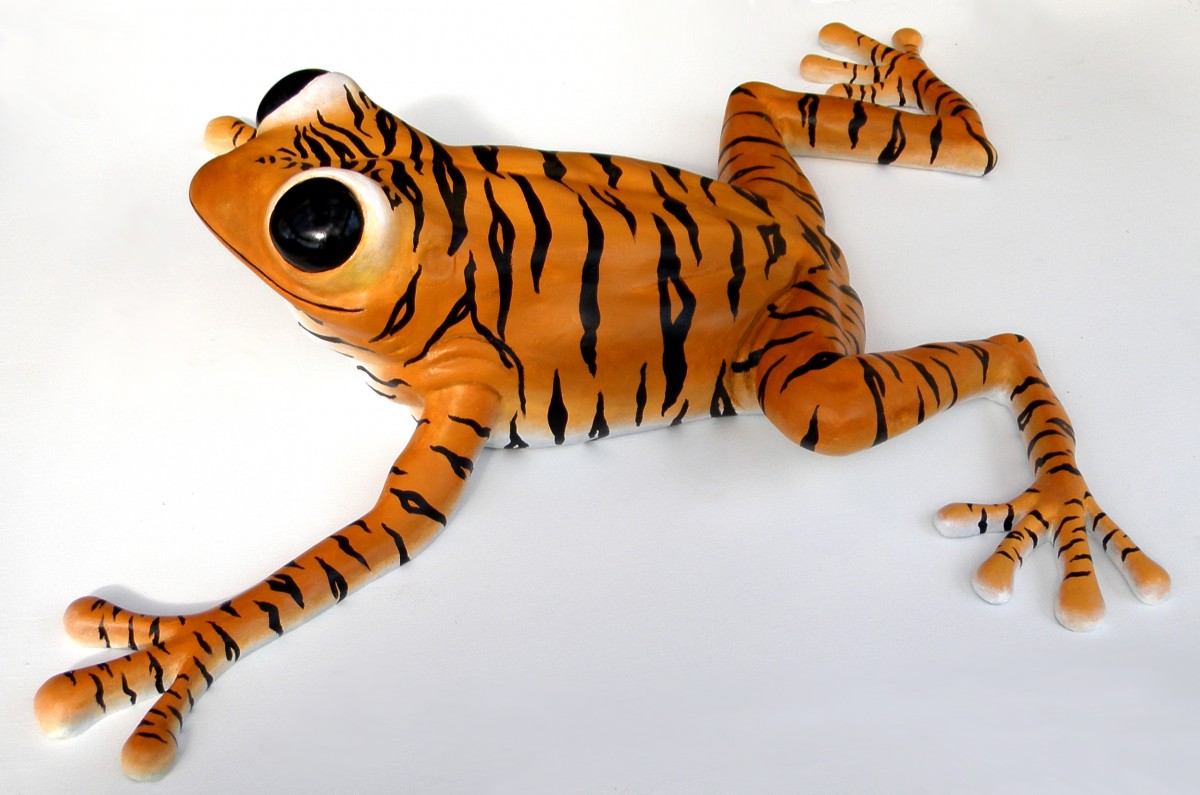
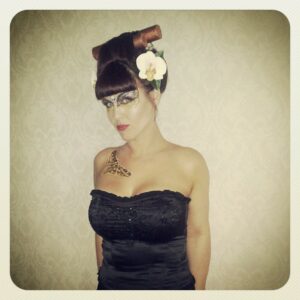
Interview with visionary sculptor Clare Ferguson-Walker, who says about her work: “I find making sculptures incredibly hard work, requiring an enormous amount of patience, but they haunt me in visions almost constantly and the only thing I can do to relieve the pressure of that is to make them.” Clare has a home-based workshop in Wales where she lives with her two children.
Leslie: If I came across your sculptures in a gallery, what would they look like and be made of? What would be their general themes and areas of interest?
Clare: They would be figurative and surreal, beautiful and often creepy. As self-indulgent as it sounds, they are often self-portraits even if they don’t directly resemble me, they will often represent revelations I’ve had or ongoing struggles that I endure; they are a narrative of my subconscious mind’s engagement with the physical world. They could be made of ceramic, bronze or bronze resin and are often painstakingly hand-painted.
Leslie: How are your artworks different – or are they ‘translations’ of your sculptures into another medium?
Clare: My paintings often deal with the same themes, I love the challenge of recreating a 3 dimensional object in 2 dimensions, paintings are more challenging for me, I’m naturally more adept at sculpture.
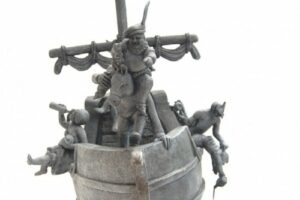
Leslie: Tell us about how your sculptures begin, grow and develop.
Clare: I see them as finished visions in my mind’s eye, often before I go to sleep, I think the veil between the dream world and physical world is thin at that point. Sometimes I’m overwhelmed by hundreds of images, I usually make the ones that keep coming back. I often work out the minutiae of their meanings after they’ve been made, like interpreting a dream, they are a symbolic visual language that transcends the spoken word. I never draw them first or use visual reference for the human figures, I will sometimes look at a specific animal if it features. I know exactly how it will look before I start, it’s then a question of manifesting it. Depending on the form I might need a wire armature to begin, I have on rare occasions used modelling materials that don’t need to be fired and can be sold as a one off; material such as super sculpey and magicsculpt are good for that, however I much prefer working with traditional clay, and once that is placed around metal it cannot be fired. Some pieces take such a long time that it feels efficient to have a mould made and multiple casts produced.
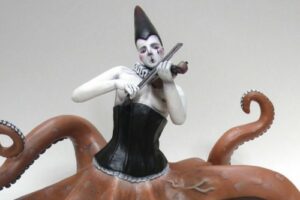
Leslie: Can you give examples of the ‘enormous hard work’ and ‘patience’ that went into some (or one) of your pieces?
Clare: I’m a perfectionist and I like a completely flawless, smooth finish. This takes an inordinate amount of time to achieve especially on a small scale. “Ship of Fools” and “Sorrowful Siren” each took about a year to complete, the tiny fiddly details had to be achieved with a pin at certain points, and you have to hold your body at difficult angles which causes muscle strain. I’ve never abandoned a piece, I believe that you have to look for solutions to problems. The mast on the ship was really challenging, it kept collapsing overnight, I realised it was massively top heavy so used a metal rod rather than wire and then carved polystyrene for the rest of the sails as it’s super light. I learned a lot from that piece. I never work with other people, I’m hard enough to work with alone!
Leslie: What recurrent tropes from folklore and mythology have appeared in your work? How have they presented themselves? Why them?
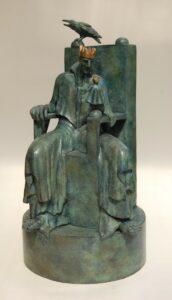
Clare: Rhiannon from the Mabinogion has featured a fair few times, she rides a magical horse and no man can catch her, she’s a feminist heroine of mine! In folklore, certain animals often carry symbolic meaning and these turn up time and time again: butterflies and frogs represent metamorphosis, for example. I went though a phase of crowning lots of characters and realised royalty often features in fairy tales. For me though the crown is about sovereignty of the self as opposed to a political or hereditary position; to be the ruler of one’s own destiny is of paramount importance to me. “The Lonely King” for example could be any person struggling with an authoritarian position, struggling with the loneliness of narcissism. I also often find myself drawing on icon-like poses to represent an affinity with a greater spiritual power, in many religions women are cast as vessels of sin. I’m looking to rewrite that, in “The Sacred Wound” for example the mother deliberately reflects mother Mary in her pose with the child, she is however anything but virginal, she’s a highly charged sexual being, completely at ease with her body.
Leslie: Looking back, how did your early life foreshadow your present career as a sculptor/artist?
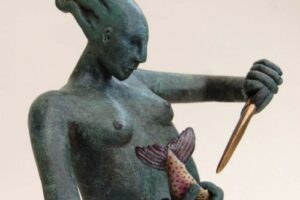
Clare: I had an extremely eccentric childhood: my father is a hoarder of fascinating things, our house was full of great books on all manner of subjects along with fossils, rocks, skulls and stuffed animals, intricate equipment and artwork. My mother was a fantastic painter who never fully pursued it as a career but who taught me several invaluable techniques. I was given a great deal of freedom to explore my interests, I loved creatures from other worlds, ghost stories, mysterious unexplained phenomena and fairy tales, the weirder the better. I watched films like Labyrinth and the Dark Crystal almost obsessively and spent hours and hours drawing the characters and making my own up. My dad also had loads of erotic photography books that I was totally fascinated by and I credit these for my almost photographic recall of the human figure. We were taken to museums, art galleries and given access to swathes of historic artistic references through books, I’ve spent many hours moaning about all that my parents did wrong, as I’ve got older, I’ve come to realise they were actually incredible people who gave my sister and me extraordinary childhoods.
Leslie What have you learned about yourself as a result of your creative work?
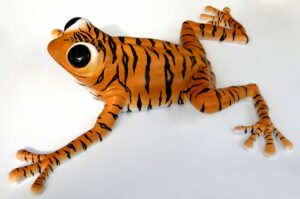
Clare: That I’m a weirdo!!! I’m often shocked when people find my work creepy. I’ve also learned that I have a large capacity for patience and I take my work really seriously. I want to communicate with the world, and I’m as interested in questions as I am in answers.
Leslie: Can you sum up your view of the human condition, as represented in your art?
Clare: We are god-like in our ability to create and fathom and yet as fragile and vulnerable as glass. “The Glass Gods”…. I sense a vision coming on!!
Next week I interview human right campaigner, journalist, teacher and social historian Caitlin Davies, who is the author of several books about powerful women.
ABOUT LESLIE TATE’S BOOKS:

I interviewed poet & artist Jane Burn who won the Michael Marks Environmental Poet of the Year 2023-24 with A Thousand Miles from the Sea.

I interviewed ex-broadcaster and poet Polly Oliver about oral and visual poetry, her compositional methods, and learning the Welsh language. Polly says, “I absolutely love

I interviewed Jo Howell who says about herself: “I’ve been a professional photographic artist since I left Uni in 2009. I am a cyanotype specialist.


Poet Tracey Rhys, writer of Teaching a Bird to Sing and winner of the Poetry Archive’s video competition reviews Ways To Be Equally Human. Tracey,
| Cookie | Duration | Description |
|---|---|---|
| cookielawinfo-checkbox-analytics | 11 months | This cookie is set by GDPR Cookie Consent plugin. The cookie is used to store the user consent for the cookies in the category "Analytics". |
| cookielawinfo-checkbox-functional | 11 months | The cookie is set by GDPR cookie consent to record the user consent for the cookies in the category "Functional". |
| cookielawinfo-checkbox-necessary | 11 months | This cookie is set by GDPR Cookie Consent plugin. The cookies is used to store the user consent for the cookies in the category "Necessary". |
| cookielawinfo-checkbox-others | 11 months | This cookie is set by GDPR Cookie Consent plugin. The cookie is used to store the user consent for the cookies in the category "Other. |
| cookielawinfo-checkbox-performance | 11 months | This cookie is set by GDPR Cookie Consent plugin. The cookie is used to store the user consent for the cookies in the category "Performance". |
| viewed_cookie_policy | 11 months | The cookie is set by the GDPR Cookie Consent plugin and is used to store whether or not user has consented to the use of cookies. It does not store any personal data. |
2 responses
Hi Leslie, I can relate to Clare’s love of sculpture as I like this form of art too. 3-D artworks are very expressive. I think Clare’s artworks are amazing and expressive, I don’t find them creepy at all.
Interesting… I find them quite macabre but very much her own style – which is why I wanted Clare on my blog. As you know, it’s the distinctive, signature style that recognisably belongs to a book or work of art that makes us take notice! I really like Clare’s work.